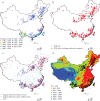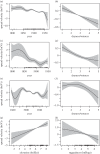Wet climate and transportation routes accelerate spread of human plague - PubMed (original) (raw)
Wet climate and transportation routes accelerate spread of human plague
Lei Xu et al. Proc Biol Sci. 2014.
Abstract
Currently, large-scale transmissions of infectious diseases are becoming more closely associated with accelerated globalization and climate change, but quantitative analyses are still rare. By using an extensive dataset consisting of date and location of cases for the third plague pandemic from 1772 to 1964 in China and a novel method (nearest neighbour approach) which deals with both short- and long-distance transmissions, we found the presence of major roads, rivers and coastline accelerated the spread of plague and shaped the transmission patterns. We found that plague spread velocity was positively associated with wet conditions (measured by an index of drought and flood events) in China, probably due to flood-driven transmission by people or rodents. Our study provides new insights on transmission patterns and possible mechanisms behind variability in transmission speed, with implications for prevention and control measures. The methodology may also be applicable to studies of disease dynamics or species movement in other systems.
Keywords: climate; movement ecology; spread route; spread velocity; third plague pandemic; transportation.
Figures
Figure 1.
(a) Plague invasion process in China during the third plague pandemic from 1772 to 1964. Points show counties where human plague was observed, with the colour showing the year when the first case was reported within the county boundary. (b) Location of hydrological stations with D/W data (blue triangle). Arrows indicate the hydrological station used for analysis of how climate affects plague spread for counties where plague manifested. (c) Red points indicate where the plague-infected county had a road going through, and blue points shows where the infected county had no major road going through. Blue lines indicate the largest rivers in China. (d) Elevation map (unit: metre) and political central location of counties with plague outbreaks. Only counties with confirmed plague cases are shown.
Figure 2.
Two methods were used to estimate plague spread speed during the third pandemic in China. (a) TSA. Contours were drawn based on the trend surface, which presented the predicted plague invasive year. The slope of the trend surface represents the reciprocal plague spread speed. Red points indicate the location of counties with cases of plague infection. (b) NNA. Arrows were drawn to the plague-invaded counties from the nearest neighbour counties where plague appeared earlier. Plague spread speed was the length of arrows divided by the difference in the first plague-invaded year between the counties. Only counties with confirmed plague cases are shown.
Figure 3.
Partial effects on plague spread velocities calculated by NNA methods. Partial effects are estimated from the GAM by correcting for effects of other variables. (a) Temporal trend in the whole of China. (b) Dryness/wetness effects in the whole of China. (c) Temporal trend in South China. (d) Dryness/wetness effects in South China. (e) Temporal trend in North China. (f) Dryness/wetness effects in North China. (g) Elevation effect in North China. (h) Ruggedness effect in North China. In addition, effects of location, plague prevalence, roads, rivers and coastline were accounted for (see text and electronic supplementary material).
Similar articles
- Historical and genomic data reveal the influencing factors on global transmission velocity of plague during the Third Pandemic.
Xu L, Stige LC, Leirs H, Neerinckx S, Gage KL, Yang R, Liu Q, Bramanti B, Dean KR, Tang H, Sun Z, Stenseth NC, Zhang Z. Xu L, et al. Proc Natl Acad Sci U S A. 2019 Jun 11;116(24):11833-11838. doi: 10.1073/pnas.1901366116. Epub 2019 May 28. Proc Natl Acad Sci U S A. 2019. PMID: 31138696 Free PMC article. - Nonlinear effect of climate on plague during the third pandemic in China.
Xu L, Liu Q, Stige LC, Ben Ari T, Fang X, Chan KS, Wang S, Stenseth NC, Zhang Z. Xu L, et al. Proc Natl Acad Sci U S A. 2011 Jun 21;108(25):10214-9. doi: 10.1073/pnas.1019486108. Epub 2011 Jun 6. Proc Natl Acad Sci U S A. 2011. PMID: 21646523 Free PMC article. - Identifying the spatiotemporal clusters of plague occurrences in China during the Third Pandemic.
Sun Z, Zhang Z, Liu Q, Lyu B, Fang X, Wang S, Xu J, Xu L, Xu B. Sun Z, et al. Integr Zool. 2020 Jan;15(1):69-78. doi: 10.1111/1749-4877.12411. Integr Zool. 2020. PMID: 31305020 - Between flood and drought: How cities are facing water surplus and scarcity.
Dąbrowska J, Menéndez Orellana AE, Kilian W, Moryl A, Cielecka N, Michałowska K, Policht-Latawiec A, Michalski A, Bednarek A, Włóka A. Dąbrowska J, et al. J Environ Manage. 2023 Nov 1;345:118557. doi: 10.1016/j.jenvman.2023.118557. Epub 2023 Jul 8. J Environ Manage. 2023. PMID: 37429091 Review. - Modeling, challenges, and strategies for understanding impacts of climate extremes (droughts and floods) on water quality in Asia: A review.
Fabian PS, Kwon HH, Vithanage M, Lee JH. Fabian PS, et al. Environ Res. 2023 May 15;225:115617. doi: 10.1016/j.envres.2023.115617. Epub 2023 Mar 4. Environ Res. 2023. PMID: 36871941 Review.
Cited by
- Acceleration of plague outbreaks in the second pandemic.
Earn DJD, Ma J, Poinar H, Dushoff J, Bolker BM. Earn DJD, et al. Proc Natl Acad Sci U S A. 2020 Nov 3;117(44):27703-27711. doi: 10.1073/pnas.2004904117. Epub 2020 Oct 19. Proc Natl Acad Sci U S A. 2020. PMID: 33077604 Free PMC article. - Correlation analysis between the occurrence of epidemic in ancient China and solar activity.
Chen S, Wei Y, Yue X, Xu K, Li M, Lin W. Chen S, et al. Sci China Earth Sci. 2023;66(1):161-168. doi: 10.1007/s11430-022-9986-5. Epub 2022 Dec 19. Sci China Earth Sci. 2023. PMID: 36575769 Free PMC article. - Trade routes and plague transmission in pre-industrial Europe.
Yue RPH, Lee HF, Wu CYH. Yue RPH, et al. Sci Rep. 2017 Oct 11;7(1):12973. doi: 10.1038/s41598-017-13481-2. Sci Rep. 2017. PMID: 29021541 Free PMC article. - Climate Change and Vector-Borne Diseases in China: A Review of Evidence and Implications for Risk Management.
Wu Y, Huang C. Wu Y, et al. Biology (Basel). 2022 Feb 25;11(3):370. doi: 10.3390/biology11030370. Biology (Basel). 2022. PMID: 35336744 Free PMC article. Review. - Climate and society in long-term perspective: Opportunities and pitfalls in the use of historical datasets.
van Bavel BJP, Curtis DR, Hannaford MJ, Moatsos M, Roosen J, Soens T. van Bavel BJP, et al. Wiley Interdiscip Rev Clim Change. 2019 Nov-Dec;10(6):e611. doi: 10.1002/wcc.611. Epub 2019 Aug 8. Wiley Interdiscip Rev Clim Change. 2019. PMID: 31762795 Free PMC article. Review.
References
Publication types
MeSH terms
LinkOut - more resources
Full Text Sources
Other Literature Sources
Medical
Molecular Biology Databases


